Swimming with jellyfish is on many people’s bucket list. In this guide I tell you how to get to the Jellyfish Lake in Palau, how much it cost and some extra useful information about it.
Probably the single most fascinating spot I went in 2019 was by far the Jellyfish Lake in Palau. This natural wonder was on my bucket list for years and when the opportunity came out to visit this unique place, I was extremely excited about it. In this guide, I summarized all information about the Jellyfish Lake, which tours can you do, how much they cost and in general how to get to the famous Jellyfish Lake in Palau.
Be connected at all times in Palau.
I recommend an e-SIM with Airalo. With them, I bought a plan of 10 GB for my whole stay in most countries.
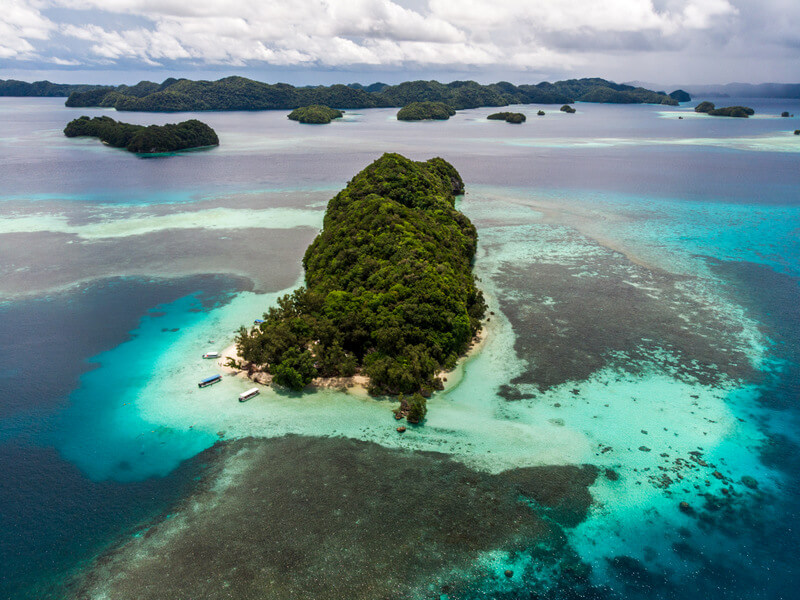
Swim with millions of jellyfish
Swimming with jellyfish might sound for many as some kind of bizarre dream – well, it’s not. Although jellyfish are extremely dangerous species and swimming with them should be avoid in most circumstances, there are several locations in the world where this dream can come true. The most famous are the jellyfish lagoon in Raja Ampat Islands and Kakaban island in Indonesia, as well the Jellyfish Lake in Eil Malk, Palau.
Although I never visited the jellyfish lakes in Raja Ampat or Kakaban, I heard several stories about the almost inexistent protective laws of these fragile ecosystems and the over tourism of the region. On the other side, Palau restrictive access to the lake and environmental concern is keeping the environment clean.
About 40 minutes away from the city of Koror by boat, the jellyfish Lake is a marine lake located at Eil Malk island. This whole area is called the Rock Islands and although the Jellyfish Lake is the country’s biggest attraction, the whole Rock Islands archipelago is a magnificent marine sanctuary and home for some of the most untouched marine life in the world.
After being closed for almost two years due to a drought, the lake reopened beginning of 2019 after the jellyfish population increased. I decided to give it a visit and learn more about these very fascinating creatures. Of course I also had to take a dip in the lake and experience being around millions of jellyfish underwater.
Read more: How to plan a trip to Palau
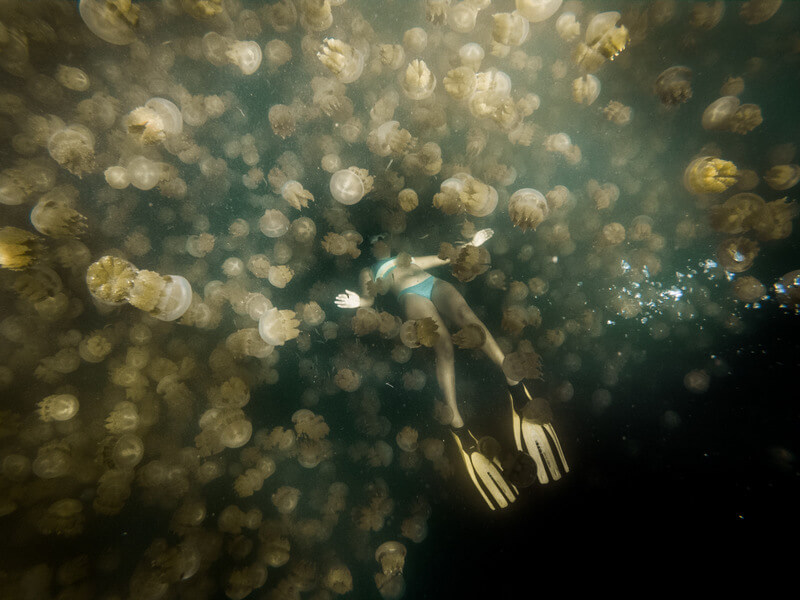
How to get to the Jellyfish Lake
A visit to the Jellyfish Lake is not a cheap. As most isolated islands, flight connections come only from neighboring countries and a visit to Palau from Europe or North America could take at definitely a couple of days on a plane and at least 700 Euros on a plane ticket.
NOTE: Flights from Frankfurt start at 560 EUR in low season via Taipei or Seoul.
Once in the island, prices are very high as well and even a low-end daily budget would be around 100 EUR/day – Just the 6km ride from Koror Airport to the city center will cost 25 USD.
Tours to the Jellyfish Lake are relatively expensive too. All visitors are required to purchase a 10-day Rock Island Permit for 100 USD (50 USD if you access the Rock Islands but not the Jellyfish Lake). Take also into consideration that if you are planning to book a day tour to the Jellyfish Lake expect to pay between 100-250 USD (excluding permit costs). According to local guides, the reason for this prices is Palau’s answer to over tourism. The country wants to test the strategy of low volume/high value – something other countries with rare fauna and flora are experimenting too.
When visiting Palau, I decided to combine several activities at the Rock Islands and the Jellyfish Lake. I was able to do a full day of diving with a quick stop at the lake and a Full Day Rock Island snorkeling tour. Kayak tours at the Rock Islands are also an interesting option for a fun and diverse day activity
Although there are at least a dozen of companies going to the Jellyfish Lake each day, most people prefer to go with one of following operators:
Tours to the Jellyfish Lake
- Sam’s Tours
- Fish ‘n Fins
- Palau Dive Adventures
- NECO Marine Palau
These tour operators established themselves as the leaders in eco-tourism in the country due to their sense of protection for the natural environment and experience.
The tours offered by them tend to be a little bit more expensive than the rest. However, they will provide you a more private experience (less people on boats) and more flexibility in each location.
Average price for some activities at the Rock Islands
Diving Tank – Day Tour
Kayak Tour
Jellyfish Lake-Rock Islands Tour
Snorkeling Tour
80-100 USD (minimum 2)
120-160 USD
120-200 USD
100-120 USD
Inside Tip: If you are visiting the Jellyfish Lake on a day tour, ask if they can visit the lake early in the morning. Jellyfish spend much of their lives moving on a daily migration that follows the sun’s arc across the sky and right after the sun comes out you can find millions of these creatures swimming on a single spot – Locals call it “the wall of jellyfish” and it’s probably the most impressive thing I’ve seen in my life.
Read more: Snorkeling and sea kayaking in the Rock Islands
Read more: 15 landscapes from 15 different countries
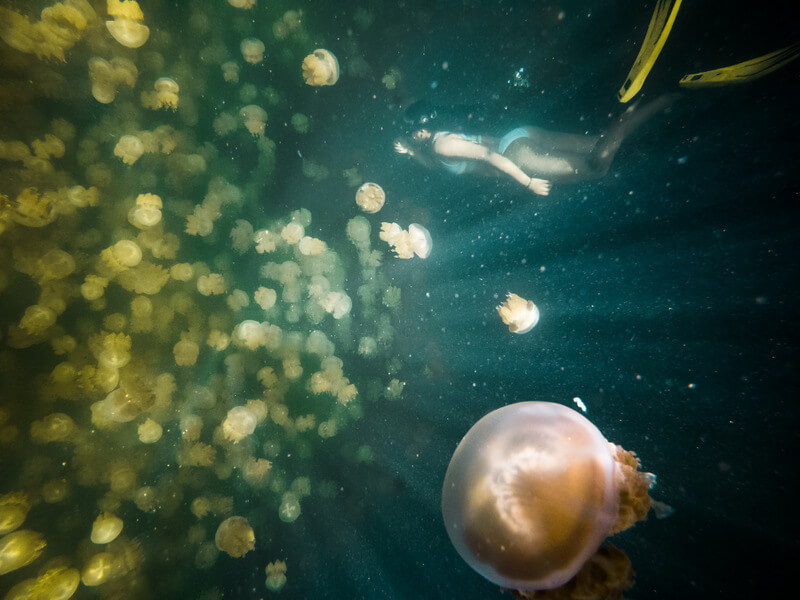
A fragile ecosystem to protect
Once at Eil Malk, we had to clean our bodies with fresh water and wash out any sunscreen we applied early in the day. After our Rock Island permits got controlled by two rangers at the entrance, we had a 15-minute trek through a forest in order to reach the lake. Although it was not obligatory, our guides recommended us to clean our feet again before jumping into the water and not use swimming fins in order to not harm the jellyfish (this last recommendation was mostly for inexperienced swimmers).
All these measures are necessary, as this is one of the most fragile places on earth. The lake was once home 20 million golden jellyfish and some experts even say it was hitting around 30 million at its peak in 2005. However, from 2007 until 2016 there was a reduction of the species. The population of jellyfish almost reached zero by 2016 and due to environmental reasons, the government decided to shut down the access to the lake. It only opened early 2019 and nowadays there is an estimate of about 2-3 million jellyfish.
Although nobody knows if this effect was caused due to the number of tourists accessing the lake every day, the government decided to increase the Rock Island 10-day Permit from 25 to 100 USD in order to restrict access. There have been even lately some discussions about increasing the price again up to 200 USD or more.
Read more: Understanding the Jellyfish Lake and its unique ecosystem
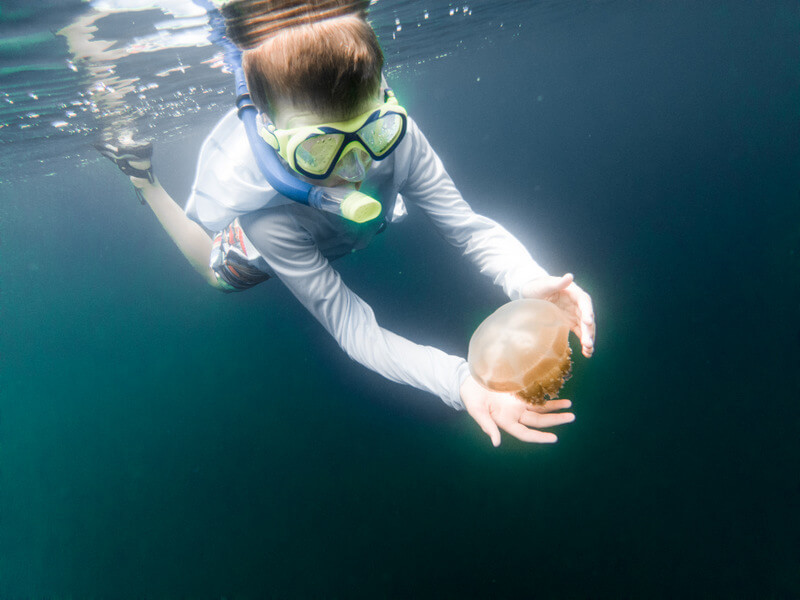
Tips for visiting Palau and the Jellyfish Lake
- Renting a car is not necessary. Most travelers stay in Koror and most tour companies offer transfers from all hotels to their diving bases. Koror is also a very small town, and everything is very easy to reach by walking distance.
- Book your hotel in advance. However, you can simply book your Jellyfish Lake tour spontaneously – choose a clear day. Most companies are flexible with their Jellyfish Lake tours and some have even boats departing every day or each second day.
- Diving is forbidden and dangerous. There is a layer of hydrogen sulfide 15 meters below surface which is poisonous for humans. Also, most jellyfish are swimming around the surface and there is not much to see below 5 meters.
- Depending on the tour you are booking, you can spend as much time as you want inside the lake. However, 45 minutes should be enough for swimming around and explore the lake by your own.
- At some point, it will be impossible to avoid jellyfish touching your skin – there are simply millions swimming around you. But don’t worry! The golden and moon jellyfish of the Jellyfish Lake do not sting. They lost that ability after thousands of years living without predators.
- Although you might read in some forums or websites about a departure tax of 50 USD when leaving Palau, it is included in the air ticket price and you don’t have to pay anything.
Read more: What is the Palau Pledge?
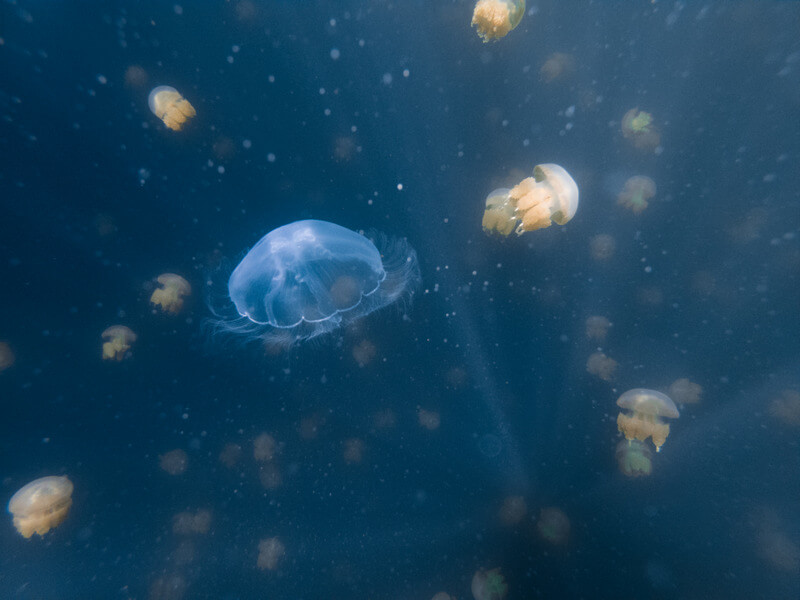
How do I find cheap flights to Palau?
Finding a cheap flight anywhere around the world is not always easy. It’s about comparing platforms, selecting the right routes and booking at the right time. Fortunately, platforms like Skyscanner became known as an all-in-one tool for booking flights at the lowest cost possible.
They analyse every potential company and sub-contractor in order to find the lowest price available for you. Not only that, but you can also select the option “Travel Anywhere” and let Skyscanner find the cheapest place to travel at any selected date.
I check all my flights first at Skyscanner, and in 90% of the cases, I find the best option for me to book.
Also, by booking here using Skyscanner, you will support my blog and help me create more amazing and useful content.





